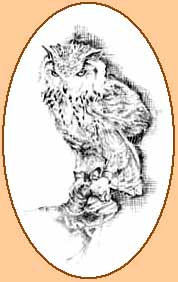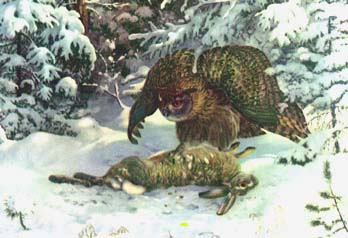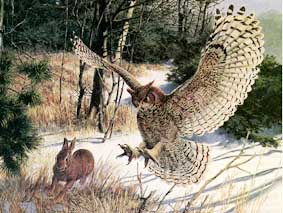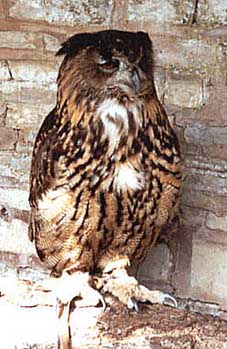Eagle Owl

Drawing, photos
and translation into English:
Yevheniia Mikheenko
The Eagle Owl (Ukrainian v puhach; Russian v filin)
is the largest of the owls,
The formidable night predator is potentially capable of hunting large prey, hence the common stereotype
of the Eagle Owl as the enemy of the hunters-game.
In the fundamental work "The Birds of Russia" (Птицы России) published in 1901, the feeding spectrum
of the Eagle Owl given as including the Hare, the Rabbit, the Capercaillie, the Willow Grouse, the Hazel
Grouse, the Black Grouse, the Duck, the Goose, various birds of prey, the Raven, other Owl species,
the Mouse, the Rat and even the Hedgehog. Regretfully, biased interpretation of the data in the former
USSR lead to the Eagle Owl being labelled as harmful or pests of the hunting industry.
The Eagle Owl faced especially difficult times with the rise of Communists. To explain the food shortages
that often accompanied the regime, the government created-enemies- which could be blamed for any disaster.
The basis for accusations that the Eagle Owl was a pest were the works of scientists pressured by the system.
Characteristically, most of such works (e.g Юргенсон, 1934*) fall on the third decade of last century, a time
when not only humanity was artificially divided into warring classes, but the animal kingdom split into the
useful and the harmful.
Unfortunately, up to now in modern hunters- or scientific editions the Eagle Owl-s tendency to prey on the
Hare and large fowl is pointed to almost as the bird-s original sin before Man.

The Bengal Eagle Owl
The Eagle Owl is widespread in Europe, North Africa,
Western and Central Asia and China. In Ukraine from
1990-s the bird has become an endangered settled
species nesting across the whole territory.
The birds inhabit old, dense forests, far from human
habitation. In the South they keep to deep ravines or
gorges by rivers. Males and females are almost identical
in colouring, though the latter are noticeably larger.
Very rarely, the Eagle owl will occupy old abandoned
nests.
Eggs are laid at the end of March or beginning of April in crevices of cliffs or ruins, in niches safe from
flooding during rain, or simply on the ground among tree roots sheltered by a neutrally-coloured stone or log.
The hatch consists of 2-3, more rarely of four or even five round eggs, which are incubated for a period of 35 days.
Rearing of hatchlings by Eagle Owls has not been investigated sufficiently. At three months the young are capable
of flying. The Eagle Owl is a night or dusk species, although in the more northern areas the bird hunts during the day.

Bubo bubo
From 1960s, in Ukraine the Eagle Owl has been
threatened as a species, as its numbers have
decreased significantly as a result of campaigns
for destruction of birds of prey, initiated several
times by the Communist regime, and also due to
the use of the insecticide DDT v so-called ?dust╕
v in the farming industry.

The American species v the Virginian Eagle Owl
(Bubo bubo virginianus) has fortunately not
come under similar threat.
(Painting by Tom Beecham)
From ancient times, the possession of an Eagle Owl by
a man was connected with unholy intentions, or seen as
denoting a follower of satanic beliefs.
The tradition has established itself in the times when
the Christian Church opposed the magi,
forcing them to take refuge in secluded places.
Long before Christianity, at the start of 2nd millennium BC, the Eagle Owl was associated with a Babylonian
cult of the Winged Goddess. The birds were depicted in terracotta bas-reliefs alongside lions, greatly
exceeding the latter in size, and the Goddess herself was portrayed naked with wings and talons of an
Eagle Owl instead of legs.
The image of the Goddess as half-woman-half-bird is characteristic of the Babylonian culture, where protective
deities incorporated strong totemic concepts. Later, the image of the Winged Goddess with clearly delineated
female attributes became widespread in the mythologies of Ancient Greece and the Mediterranean.

"The Old Man with the Eagle Owl"
by K. Vasiljev, 1976;
Since the spread of Christianity in Kyivan Rus,
the votaries of the pagan cult, before their final
loss of influence upon the people,
escaped from persecution to sequestered,
unnavigable places, where they continued
to serve their gods.
The magi, in particular, used the Eagle Owls as
hunting birds providing their food.
In conditions of illegal or semi-legal existence,
this was one of the few practical ways of survival,
as the owls were capable of satisfying the humans-
minimum protein requirements.
Potential prey for the Eagle Owl included a wide
spectrum of game which, at dusk, fall into a state
close to sleep.
Hunting in twilight or at night allowed the magi
to remain unnoticed, especially by the owners
of lands and hunting grounds.

An Eagle Owl called Reagan
(Stratford-upon-Avon, 2001)
At the moment, in Ukraine the Eagle Owl is used as a hunting bird
only sporadically rather than systematically. Therefore, the methods
of training the birds are, unfortunately, almost lost. Recently, several
amateurs have attempted keeping and training an Eagle Owl. However,
successful hunting has not yet followed. One of the reasons is probably
the lack of clearly outlined laws concerning hunting, as well as a lack
of proper hunting grounds and traditions.
However, review of 2001 video material from the UK gives an
encouraging view of British falconers, who successfully demonstrate
to the public excellent examples of interaction between the Eagle Owl
and the falconer.
The birds show amazing ability of communication, are obedient and
highly intelligent. Hunting with such well-trained birds is, of course,
possible.
__________________
* Юргенсон П.Б. "Биологические основы дичеразведения", 1934; (The Biological Basis of Game Keeping);
A bright example is the attempt of destroying so-called harmful bird species such as the Sparrow, accused of lowering
the grain harvest, in Communist China during the Cultural Revolution. Many other species were destroyed together with sparrows, as is often the case in such campaigns. The result of mass obliteration of background bird species was an ecological catastrophe v rapid and manifold increase in the numbers of insects, which, free of the biological control by their natural enemies, consumed plants cultivated by the farming industry.
╘
Ukrainian magazine "Naturalist"